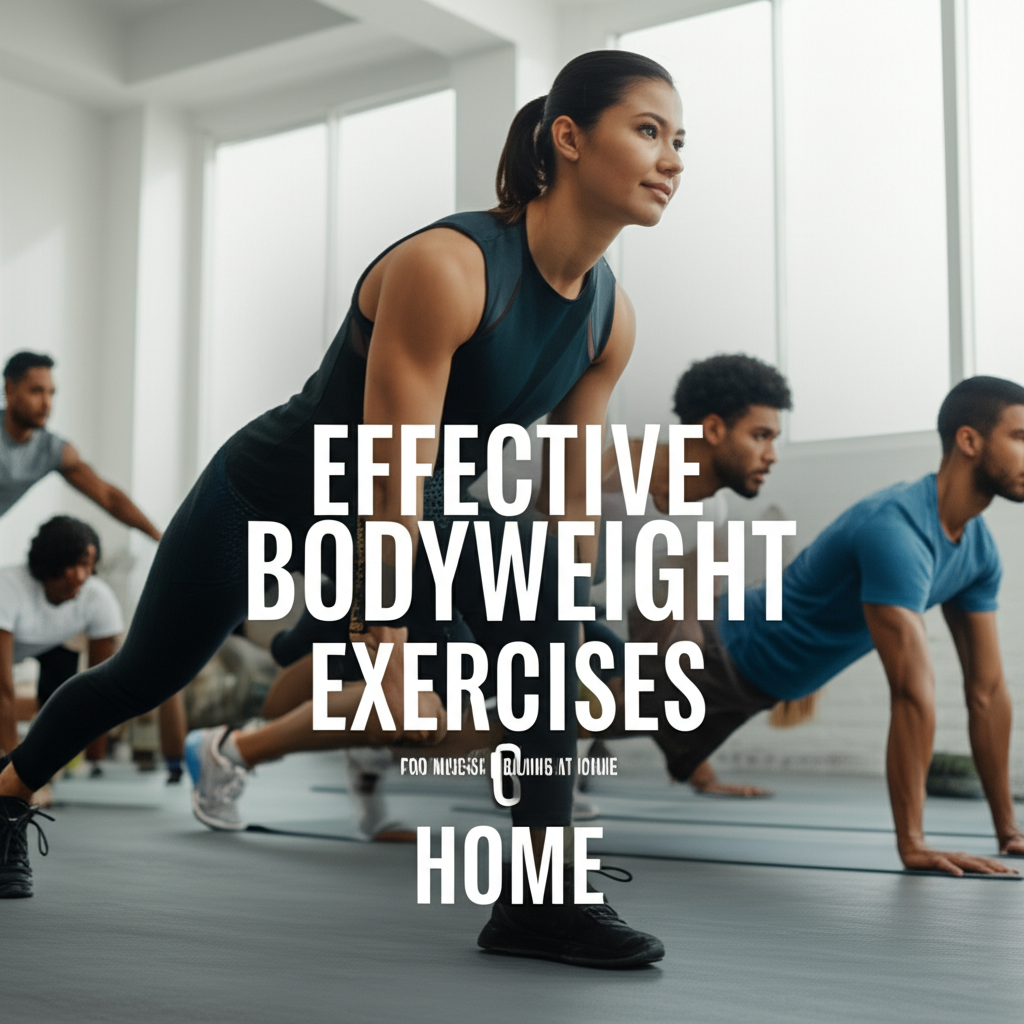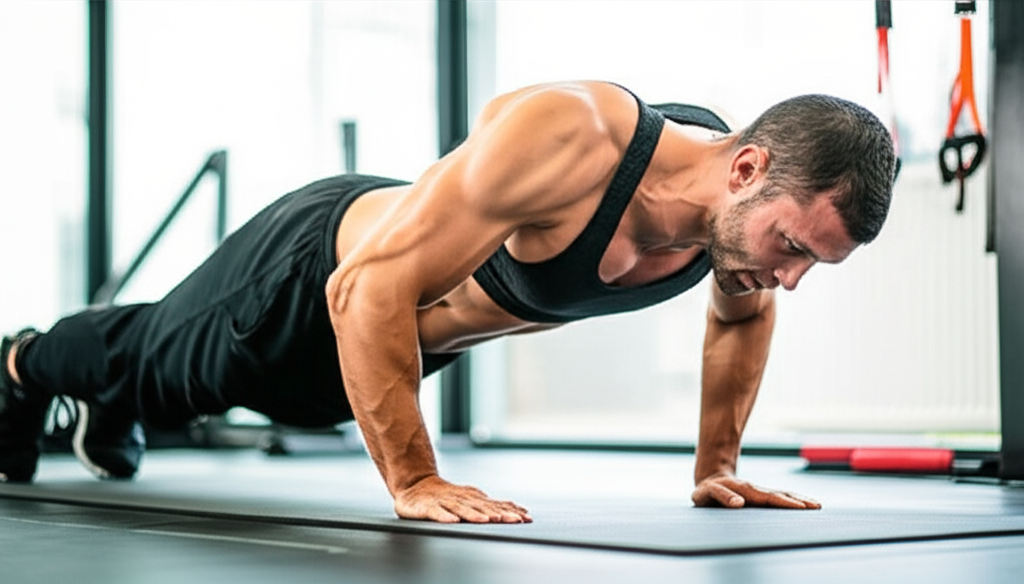Effective Bodyweight Exercises for Muscle Building at Home

Build muscle effectively at home with essential bodyweight exercises. This guide offers a beginner-friendly, step-by-step approach to maximizing your gains without any equipment.
Key Takeaways

- Master foundational bodyweight moves for muscle growth.
- Progress exercises to continually challenge your muscles.
- Focus on proper form for safety and better results.
- Combine exercises for a full-body workout routine.
- Consistency is key for significant muscle building progress.
- Incorporate rest and nutrition for muscle recovery and growth.
Are you looking to build muscle but find the idea of hitting the gym daunting, or perhaps you simply prefer the convenience of working out at home? You’re not alone! Many people assume that serious muscle building requires heavy weights and specialized equipment. The good news is, it doesn’t have to. With the right approach, you can achieve significant muscle gains using just your own body weight. This guide will walk you through effective bodyweight exercises for muscle building at home, making the process simple and achievable for beginners.
Effective Bodyweight Exercises for Muscle Building at Home
Building muscle is a journey that can be undertaken from the comfort of your own home. By understanding and implementing the right bodyweight exercises, you can stimulate muscle growth, improve strength, and enhance your overall fitness. This isn’t about quick fixes; it’s about intelligent training that leverages the power of your bodyweight to create the resistance needed for hypertrophy, the process of muscle growth.
Why Bodyweight Exercises Work for Muscle Building
You might be wondering how simply using your body can lead to muscle growth. The principle is simple: muscles grow when they are challenged beyond their usual capacity. This challenge, known as progressive overload, can be achieved through various means, even without weights. Bodyweight exercises provide resistance by making you move your body against gravity. As you get stronger, you can increase the difficulty of these exercises to continue challenging your muscles.
The American Council on Exercise (ACE) highlights that bodyweight training is a highly effective method for strengthening and toning muscles across the entire body. It’s also incredibly accessible, requiring no special equipment and allowing you to exercise anytime, anywhere. This makes it an ideal starting point for anyone keen on muscle building.
Foundational Bodyweight Exercises: Your Muscle-Building Toolkit
To effectively build muscle at home, focus on compound movements. These exercises work multiple muscle groups simultaneously, offering more bang for your buck and stimulating a greater overall muscle response. Here are the cornerstones of a good bodyweight muscle-building program:
1. Push-Ups (Chest, Shoulders, Triceps)
Push-ups are a classic for a reason. They target your chest, shoulders, and triceps effectively. For beginners, mastering a standard push-up is crucial. If a standard push-up is too difficult, begin with knee push-ups or incline push-ups against a sturdy surface like a counter or table. As you get stronger, you can progress to standard push-ups, then to variations that increase the challenge.
How to Perform:
- Start in a plank position, with your hands slightly wider than shoulder-width apart, palms flat on the floor, and fingers pointing forward.
- Keep your body in a straight line from head to heels, engaging your core.
- Lower your chest towards the floor by bending your elbows, keeping them relatively close to your body (not flaring out to the sides).
- Push back up to the starting position, fully extending your arms.
2. Squats (Quads, Hamstrings, Glutes)
The squat is king of lower body exercises. It works your quadriceps, hamstrings, and glutes, building a strong foundation. Proper form is vital to avoid knee strain and maximize muscle activation. Think about sitting back into a chair, keeping your chest up and your back straight.
How to Perform:
- Stand with your feet shoulder-width apart, toes pointing slightly outward.
- Keeping your chest up and back straight, lower your hips as if you’re going to sit in a chair.
- Descend until your thighs are parallel to the floor, or as low as you can comfortably go with good form.
- Push through your heels to return to the standing position.
3. Lunges (Quads, Hamstrings, Glutes, Balance)
Lunges are excellent for working each leg individually, which helps address muscle imbalances and improve balance. They target the quads, hamstrings, and glutes. Forward, backward, and side lunges all offer slightly different benefits.
How to Perform (Forward Lunge):
- Stand with your feet hip-width apart.
- Step forward with one leg, lowering your hips until both knees are bent at approximately a 90-degree angle.
- Ensure your front knee is directly above your ankle, and your back knee hovers just above the floor.
- Push off your front foot to return to the starting position.
- Repeat on the other leg.
4. Planks (Core Strength)
A strong core is essential for all strength training and everyday movements. Planks engage your entire core, including your abs, obliques, and lower back. They are a fantastic isometric exercise, meaning you hold a position to build strength.
How to Perform:
- Start in a push-up position, then lower onto your forearms, keeping your elbows directly beneath your shoulders.
- Your body should form a straight line from head to heels.
- Engage your core and glutes to prevent your hips from sagging or rising too high.
- Hold the position for the desired duration.
5. Dips (Triceps, Chest, Shoulders)
Dips are superb for targeting the triceps and lower chest. You can perform them using a sturdy chair, a bench, or even the edge of a stable table. As you get stronger, you can progress to dips on parallel bars if you have access to them.
How to Perform (with a Chair):
- Sit on the edge of a sturdy chair, placing your hands on the edge next to your hips, fingers pointing forward.
- Slide your hips off the chair, extending your legs forward. Keep your knees slightly bent for easier variations.
- Lower your body by bending your elbows until they are at about a 90-degree angle, keeping your back close to the chair
